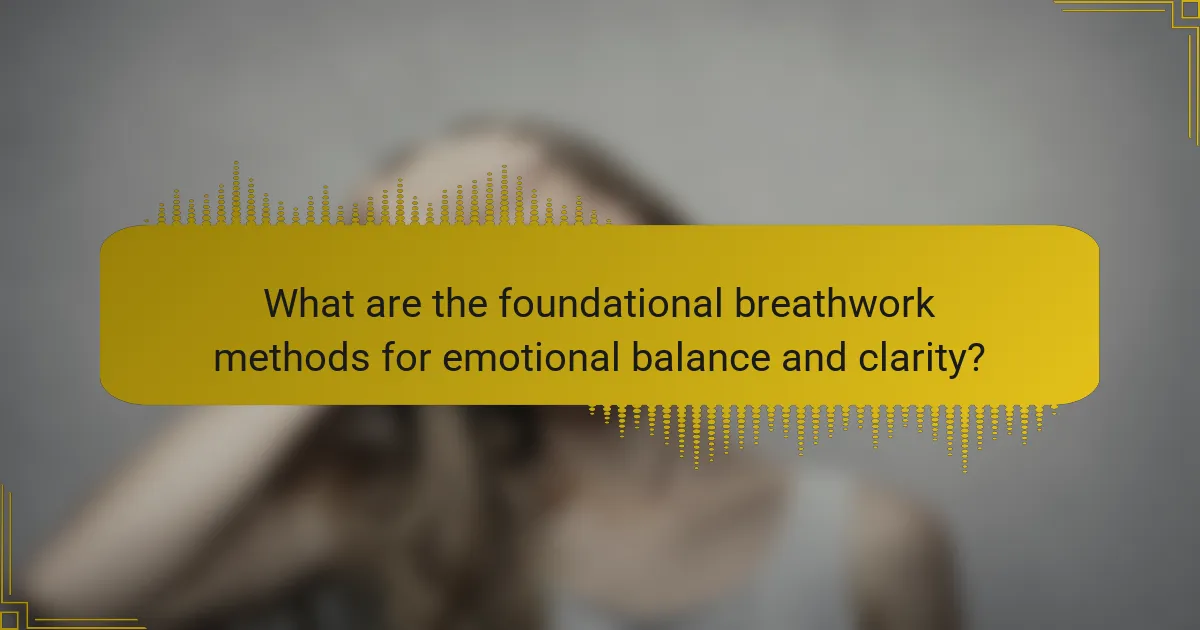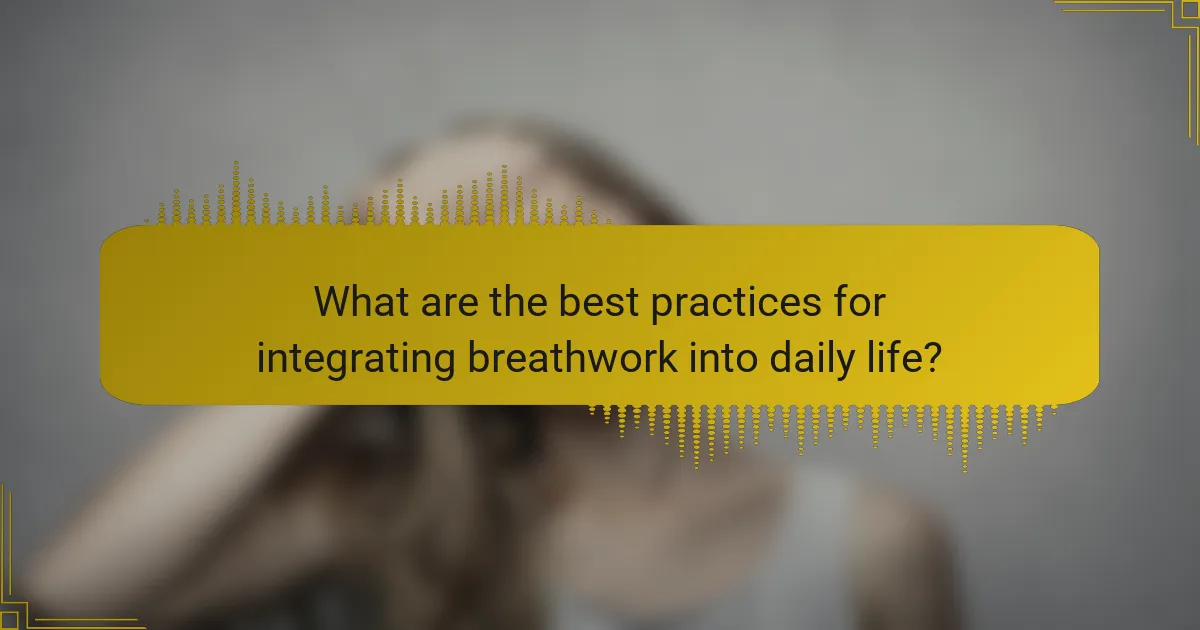Breathwork methods can significantly enhance emotional balance and clarity. Techniques such as diaphragmatic breathing, box breathing, and alternate nostril breathing promote relaxation, focus, and emotional stability. These practices facilitate deep emotional release and can be adapted to various cultural contexts. Regular integration of breathwork into daily routines fosters improved mental well-being and resilience.

What are the foundational breathwork methods for emotional balance and clarity?
Breathwork methods for emotional balance and clarity include techniques like diaphragmatic breathing, box breathing, and alternate nostril breathing. These methods enhance emotional regulation and mental clarity through controlled breath patterns.
Diaphragmatic breathing focuses on deep, abdominal breaths, promoting relaxation and reducing stress. Box breathing involves inhaling, holding, exhaling, and pausing for equal counts, fostering a sense of calm. Alternate nostril breathing balances the body’s energy, enhancing focus and reducing anxiety.
Incorporating these methods into daily routines can lead to significant improvements in emotional well-being and mental clarity. Regular practice allows individuals to develop a deeper connection with their breath, ultimately leading to greater emotional resilience.
How does conscious breathing impact emotional well-being?
Conscious breathing significantly enhances emotional well-being by reducing stress and promoting relaxation. Breathwork methods, such as deep diaphragmatic breathing, activate the parasympathetic nervous system, leading to lower anxiety levels. Research indicates that consistent practice can improve mood and emotional resilience. Techniques like box breathing and alternate nostril breathing facilitate mental clarity and emotional balance, allowing individuals to manage their emotions effectively.
What role does breath regulation play in stress reduction?
Breath regulation significantly reduces stress by activating the parasympathetic nervous system. This leads to decreased heart rate and lower cortisol levels, promoting relaxation. Techniques such as deep breathing enhance emotional balance and clarity, making them effective in managing stress. Regular practice can improve overall mental well-being.
What are the core features of breathwork practices?
Breathwork practices focus on techniques that enhance emotional balance and clarity. Key features include various methods like diaphragmatic breathing, which promotes relaxation, and holotropic breathwork, known for deep emotional release. Additionally, structured sessions often incorporate guided imagery to deepen the experience. These practices can lead to improved mental clarity and emotional stability through intentional breathing patterns.

What unique benefits do specific breathwork techniques offer?
Specific breathwork techniques offer unique benefits that enhance emotional balance and clarity. Techniques like diaphragmatic breathing reduce anxiety by activating the parasympathetic nervous system, promoting relaxation. Box breathing improves focus and concentration, making it effective for stress management. Alternate nostril breathing balances the left and right hemispheres of the brain, fostering emotional stability. Each method provides distinct pathways to emotional regulation, contributing to overall mental well-being.
How does the Wim Hof Method enhance emotional resilience?
The Wim Hof Method enhances emotional resilience by combining breathwork, cold exposure, and meditation. This practice fosters a sense of control over stress responses, promoting emotional stability. Research shows that regulated breathing lowers anxiety levels, which contributes to improved emotional balance. Additionally, the method’s unique attribute of integrating cold exposure can boost mood and increase mental clarity. As a result, practitioners often report heightened emotional awareness and resilience in challenging situations.
What is the significance of Holotropic Breathwork in emotional healing?
Holotropic Breathwork significantly aids emotional healing by facilitating deep self-exploration and releasing repressed emotions. This method enhances emotional clarity, promotes catharsis, and fosters personal transformation. Participants often report profound shifts in awareness and emotional release, leading to improved mental well-being. The unique attribute of Holotropic Breathwork lies in its ability to access non-ordinary states of consciousness, allowing for deeper emotional processing. As a result, many individuals find lasting relief from anxiety, trauma, and emotional blockages through this practice.

What are the rare attributes of breathwork methods for emotional clarity?
Breathwork methods for emotional clarity have several rare attributes that enhance their effectiveness. These methods can facilitate deep emotional release, enabling individuals to confront suppressed feelings. Additionally, some techniques incorporate specific sound frequencies, which can amplify emotional processing. Another rare attribute is the use of guided visualizations paired with breathwork, creating a unique synergy that fosters profound insights. Finally, certain breathwork practices are designed to synchronize with specific lunar phases, aligning emotional work with natural cycles.
How can breathwork facilitate deep emotional release?
Breathwork can facilitate deep emotional release by promoting relaxation and enhancing self-awareness. Techniques such as conscious breathing and rhythmic patterns help access suppressed emotions. These methods create a safe space for processing feelings, leading to emotional clarity and balance. Research indicates that breathwork can reduce stress and anxiety, fostering a deeper connection to one’s emotional state.
What steps are involved in achieving emotional release through breathwork?
To achieve emotional release through breathwork, follow these essential steps:
1. **Set an Intention**: Identify the specific emotion or experience you wish to release.
2. **Choose a Breathwork Technique**: Select a method such as circular breathing or box breathing that resonates with you.
3. **Create a Safe Space**: Find a quiet, comfortable environment where you feel secure to explore your emotions.
4. **Engage in Breathwork**: Practice the chosen technique, focusing on your breath and allowing emotions to surface.
5. **Process Emotions**: After the session, reflect on your experience through journaling or meditation to integrate insights.
These steps can guide you toward emotional balance and clarity through breathwork.
What unique experiences have individuals reported from breathwork sessions?
Individuals report transformative experiences from breathwork sessions, including heightened emotional clarity, stress relief, and deep relaxation. Many describe feeling a profound sense of connection to themselves and others. Unique experiences often include vivid visualizations, emotional releases, and insights into personal challenges. Some participants note physical sensations, such as tingling or warmth, which enhance their sense of well-being. These varied responses highlight breathwork’s ability to foster emotional balance and mental clarity.

How can breathwork be adapted for different cultural contexts?
Breathwork can be adapted for different cultural contexts by integrating local practices and beliefs. This allows for emotional balance and clarity through familiar methods that resonate with participants.
Cultural adaptations may include incorporating traditional breathing techniques, such as pranayama in yoga or shamanic breath practices. These unique attributes enhance the effectiveness of breathwork by fostering a sense of belonging and cultural relevance.
Additionally, facilitators can adjust the language and imagery used during sessions to reflect cultural values. This approach ensures that participants feel comfortable and connected, promoting deeper emotional processing.
Lastly, understanding the community’s historical context can inform the breathwork practice. By acknowledging past experiences and traumas, facilitators can create a safe space for healing and clarity.
What variations of breathwork are prevalent in different regions?
Breathwork methods vary significantly across regions, each offering unique approaches to emotional balance and clarity. In India, pranayama emphasizes breath control and meditation for inner peace. In the United States, Holotropic Breathwork focuses on self-exploration through accelerated breathing techniques. In China, Qigong integrates breath with movement and energy flow for holistic health. Meanwhile, in South America, shamanic breathwork combines traditional practices with spiritual journeys. These variations reflect the cultural contexts and unique attributes of each region, enhancing the overall benefits of breathwork.
How do regional perceptions of breathwork influence its practice?
Regional perceptions of breathwork significantly shape its practice and effectiveness. Cultural beliefs, traditions, and societal norms influence how individuals engage with breathwork methods for emotional balance and clarity. For instance, in some cultures, breathwork is integrated into spiritual practices, enhancing its emotional and mental benefits. Conversely, in regions where scientific validation is prioritized, breathwork may be approached more as a therapeutic tool. Additionally, the unique attribute of community support in certain cultures fosters a collective practice, enhancing individual experiences. As a result, understanding these regional perceptions can optimize breathwork’s application, tailoring methods to align with local values and practices.

What are the best practices for integrating breathwork into daily life?
Integrating breathwork into daily life enhances emotional balance and clarity. Start by establishing a routine, dedicating specific times for practice.
Focus on different techniques, such as diaphragmatic breathing, box breathing, or alternate nostril breathing. Each method offers unique benefits, aiding stress reduction and mental clarity.
Incorporate breathwork into existing activities, like meditation or yoga, to deepen the experience. Use reminders or apps to stay consistent, tracking progress to reinforce commitment.
Lastly, create a supportive environment, free from distractions, to maximize the effectiveness of your sessions. This approach fosters a sustainable breathwork practice that promotes emotional well-being.
What common mistakes should be avoided when practicing breathwork?
Avoiding common mistakes in breathwork is crucial for achieving emotional balance and clarity. Key errors include neglecting proper posture, which can hinder breath flow; forcing breath patterns, leading to discomfort; and failing to create a safe environment, which can cause anxiety. Additionally, not setting intentions may diminish the effectiveness of the practice. Lastly, ignoring personal limits can lead to overwhelm rather than calmness.
How can one optimize breathwork for emotional balance?
Breathwork can be optimized for emotional balance by incorporating specific techniques and practices. Focus on deep diaphragmatic breathing to enhance relaxation and reduce anxiety. Use techniques like box breathing to promote clarity and focus. Establish a consistent practice schedule, ideally daily, to build resilience against emotional fluctuations. Experiment with guided sessions that target emotional release and mindfulness. Integrate visualization techniques to enhance emotional processing during breathwork sessions.
What expert insights can enhance breathwork effectiveness?
Incorporating expert insights can significantly enhance breathwork effectiveness by focusing on specific techniques and principles. Practicing diaphragmatic breathing improves oxygen flow, promoting emotional balance. Utilizing rhythmic patterns aids in achieving mental clarity. Engaging in group sessions fosters a supportive environment, amplifying the benefits. Additionally, integrating mindfulness practices enhances self-awareness, allowing for deeper emotional processing. Adopting a consistent routine solidifies these practices, leading to sustained improvements in emotional well-being.